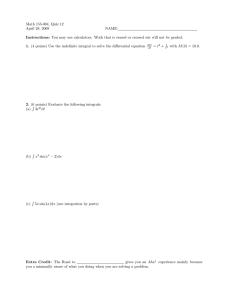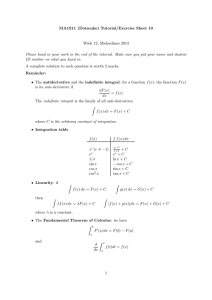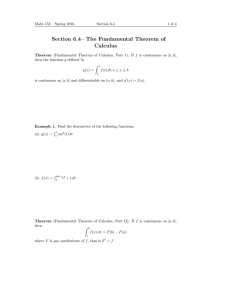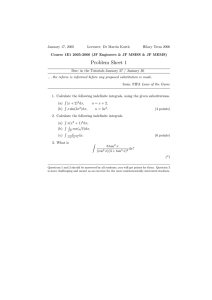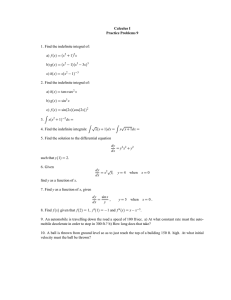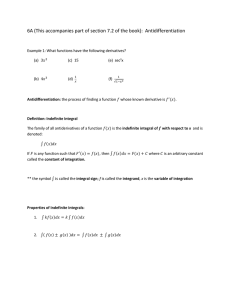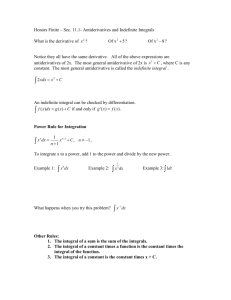Document
advertisement
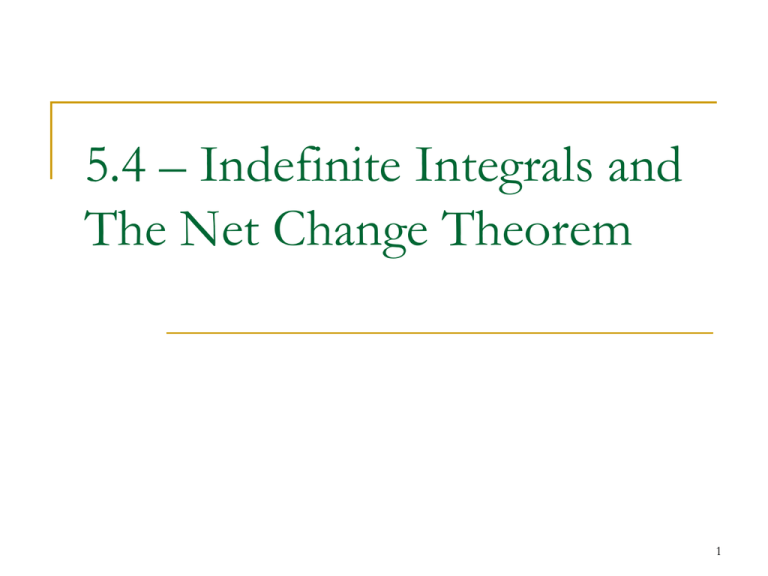
5.4 – Indefinite Integrals and The Net Change Theorem 1 Indefinite Integrals Use WolframAlpha to determine the following. f x dx integral f ( x), x a. cos x dx Question: What does b. 2 x dx f x dx represent? 2 Indefinite Integrals f x dx F x means F x f x In other words, F(x) is the _________________ of f (x). 3 Examples Evaluate each indefinite integral. 3 2 x 1. x 1/4 3 ln 3 dx x u 5 2 2. 3e sec u 2 1 u du sin 2 y 3. dy sin y 4 Definite Integrals f x dx F x b b a a F x a b where F(x) is the general antiderivative of f (x). 5 Examples 1. 2v 5 3v 1 dv 4 0 2. 2e 4 cos x dx 5 x 0 3. 9 1 4. /3 0 5. sin sin tan 2 d 2 sec 3 /2 0 sin x dx 3x 2 dx x 6 The Net Change Theorem The integral of a rate of change F x is the net change: a b F x dx F (b) F (a ) (1) Must Be A Rate Of Change Important: For the net change theorem to apply, the function in the integral must be a rate of change. Meaning: If F (x) represents a rate of change (m/sec), then (1) above represents the net change in F (m) from a to b. 7 Examples 1. The current in a wire, I, is defined as the derivative of the charge, Q. That, is b I(t) = Q(t). What does a I t dt represent? 2. A honeybee population starts with 100 bees and increases at a rate of n(t). What does 15 100 n t dt represent? 0 8 Examples 3. If f (x) is the slope of a trail at a distance of x miles from the start of the trail, what does 5 3 f x dx represent? 4. If the units for x are feet and the units for a(x) are pounds per foot, what8 are the units for da/dx. What units does 2 a x dx have? 9 Example A particle moves with a velocity v(t). What does b b a v(t ) dt and a v t dt represent? t=a ● ● t=b | s(t) 0 v t dt displacement b a b a v t dt total distance traveled 10 Examples 1. The acceleration functions (in m/s2) and the initial velocity are given for a particle moving along a line. Find (a) the velocity at time t and (b) the distance traveled during the given time interval. a t 2t 3, v 0 4, 0 t 3 11 Examples 2. Water flows from the bottom of a storage tank at a rate of r(t) = 200 – 4t liters per minute, where 0 ≤ t ≤ 50. Find the amount of water that flows from the tank in the first 10 minutes. 12
